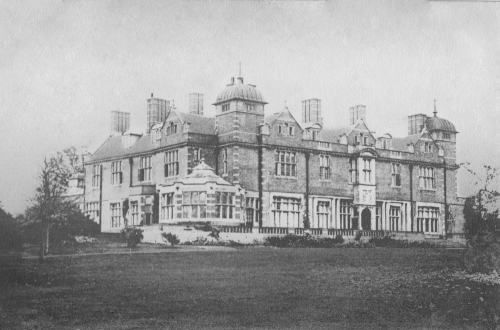Hildon House
Hampshire
| Location | Broughton | ||
| Year demolished | 1950s | ||
| Reason | Wartime requisitioning, dilapidation, surplus to requirements | ||
| See all images: | Gallery | ||
| << Back to the main list |
Hildon House, formerly known as Rose Hill, was a country estate located in the parish of Broughton, Hampshire. The estate's documented history begins in the early nineteenth century, when the first significant house on the site, Rose Hill House, was established. This original house, described in contemporary sources as a Gothic-style villa, was constructed of chalk and considered both modern and elegant for its time. The surrounding estate comprised expansive parkland and farm holdings extending into adjacent parishes such as Bossington.
Webster family ownership (1857–1902)
 By the mid-nineteenth century, the property had been acquired by Sir Augustus William Webster, 7th Baronet, a member of the landed gentry whose family formerly held Battle Abbey in Sussex. Sir Augustus took possession of Rose Hill around 1857 and resided there until his death in 1886. It was likely during his tenure that the estate's substantial stable block was constructed, featuring yellow brick with a slate roof, Dutch gables, and a prominent three-story clock tower. This structure, which survives today, was later designated a Grade II listed building.
By the mid-nineteenth century, the property had been acquired by Sir Augustus William Webster, 7th Baronet, a member of the landed gentry whose family formerly held Battle Abbey in Sussex. Sir Augustus took possession of Rose Hill around 1857 and resided there until his death in 1886. It was likely during his tenure that the estate's substantial stable block was constructed, featuring yellow brick with a slate roof, Dutch gables, and a prominent three-story clock tower. This structure, which survives today, was later designated a Grade II listed building.
Sir Augustus was succeeded by his son, Sir Augustus Frederick Webster, 8th Baronet. Shortly after inheriting the estate, the younger Webster initiated a major transformation. He demolished the original Rose Hill House and, in 1898, commissioned the architect Sir Aston Webb to design a new mansion on the site. Webb, noted for projects such as the Victoria and Albert Museum and the principal facade of Buckingham Palace, created a Renaissance Revival-style house built in white brick with stone dressings. The house featured symmetrical elevations, formal classical detailing, and a garden front adorned with a glass conservatory.
This new house, renamed Hildon House, stood as a refined example of turn-of-the-century domestic architecture. However, Sir Augustus Webster’s tenure at the new house was brief. In 1902, he sold the estate, reportedly to assist in repurchasing his ancestral home, Battle Abbey.
Briscoe family ownership (1902–1951)
The purchaser in 1902 was George Briscoe, a wealthy colonial merchant. Briscoe became the principal landowner in the area, and Hildon House served as the family seat for nearly half a century. Under his ownership, the estate maintained its status as a centre of rural society, with house parties, shooting weekends, and local philanthropic activity.Contemporary directories, such as Kelly’s Directory of Hampshire (1907), listed George Briscoe as a principal landowner in Bossington, reflecting the scale of the estate. The estate included farmland, including Crown Farm, and extended across parish boundaries. During the First World War, Briscoe's daughter, Edith Winifred Briscoe, served as a Red Cross nurse and listed Hildon House as her residence.
In July 1914, a house party was held at Hildon, with accounts describing tennis, dancing, and other entertainments. The guests included Evelyn Clark and others from industrial and landed families, indicating the estate’s role in Edwardian social life. Briscoe continued to reside at Hildon until later in life, when he moved to Dunwood Manor near Romsey.
Decline and demolition (1951–1954)
The interwar period saw the continued use of Hildon House as a private residence, but following the Second World War, the house suffered from the broader economic challenges facing large country estates. It was reportedly requisitioned during the war, and by the early 1950s, had become dilapidated. Following George Briscoe's death in 1951, the mansion was deemed surplus to requirements. In 1954, the house was demolished. Only the estate’s outbuildings, including the stable block and coach house, remained.Commercial reuse and mineral water bottling (1989–present)
In 1989, the estate entered a new phase of use when entrepreneur Christian Heppe purchased the remaining land and buildings. Recognising the value of the estate’s natural chalk aquifer, Heppe established Hildon Natural Mineral Water. The Victorian coach house was repurposed as the company’s headquarters, and the estate’s parkland was preserved as a protected water source.Hildon Ltd. went on to become a respected brand in the premium bottled water market, supplying its product both nationally and internationally. In 2017, the company was awarded a Royal Warrant as official supplier to Her Majesty Queen Elizabeth II. Although the house itself no longer stands, the Hildon estate continues in use as the source of Hildon Natural Mineral Water.